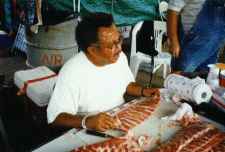Championship BBQing Techniques
Pork Ribs
Our first topic deals with the selection, preparation, barbecuing, testing and presentation of some might fine Barbecued Pork Ribs! In each section (selection, preparation, etc.) we will explain how the professionals move through the process to create award winning entries for the judges to select from. We have provided a thumbnail of each photo in the text of the this document. To see the full picture, simply 'click' the image and take a detailed look at the full size photo.
Selecting the right type of pork rib is crucial. There are many types to choose from and each has it's special characteristics. Some of the more popular ones are the Baby Back Ribs, Spare Ribs and St. Louis Cut Spare Ribs. Each team has their preferences. Our's are the St. Louis Cut. What makes the St. Louis Cut Ribs is . . . . .
 Once having selected the perfect 'rack of ribs', it is now time to prepare them for the pit. Preparation consists of trimming, membrane removal, application of the secret coating, rubbing and resting of the ribs prior to cooking. Trimming is important to the outcome of many pieces of meat. First is the removal
of the membrane located on the inside of each rack of ribs. This membrane is a tough translucent 'skin' located on the 'inside curve' of the ribs. It needs to be removed for flavor to penetrate the back side of the meat and to make eating more pleasurable. To remove the membrane, take a strong blunt instrument [ a Phillips head screwdriver makes an excellent tool] and begin the separation process. Once you can get your fingers/thumb between the membrane and meat, you can then dispense with the tool and begin to pry the two apart. Using some paper towels or napkins can reduce the effects of slipping. Once having selected the perfect 'rack of ribs', it is now time to prepare them for the pit. Preparation consists of trimming, membrane removal, application of the secret coating, rubbing and resting of the ribs prior to cooking. Trimming is important to the outcome of many pieces of meat. First is the removal
of the membrane located on the inside of each rack of ribs. This membrane is a tough translucent 'skin' located on the 'inside curve' of the ribs. It needs to be removed for flavor to penetrate the back side of the meat and to make eating more pleasurable. To remove the membrane, take a strong blunt instrument [ a Phillips head screwdriver makes an excellent tool] and begin the separation process. Once you can get your fingers/thumb between the membrane and meat, you can then dispense with the tool and begin to pry the two apart. Using some paper towels or napkins can reduce the effects of slipping.
 Next, is the trimming of the extraneous fat from the ribs. This can be a relaxing process accompanied by your favorite beverage, or a tense, uptight procedure based upon getting the food on the table. We prefer the first. If the latter is your objective, then .................. come back when you have the time to enjoy yourself! Next, is the trimming of the extraneous fat from the ribs. This can be a relaxing process accompanied by your favorite beverage, or a tense, uptight procedure based upon getting the food on the table. We prefer the first. If the latter is your objective, then .................. come back when you have the time to enjoy yourself!
Using a small paring knife, carefully remove all extraneous pieces of fat, leaving the natural fat located
"between the ribs". Remember, we are not attempting to remove all the fat, because much of it will be necessary for creating moist ribs by self basting during the cooking process. What we are looking to accomplish is to remove the 'larger' pieces that lie on the outside of the meat - - - not inside the ribs!
Continued on Page 2 |